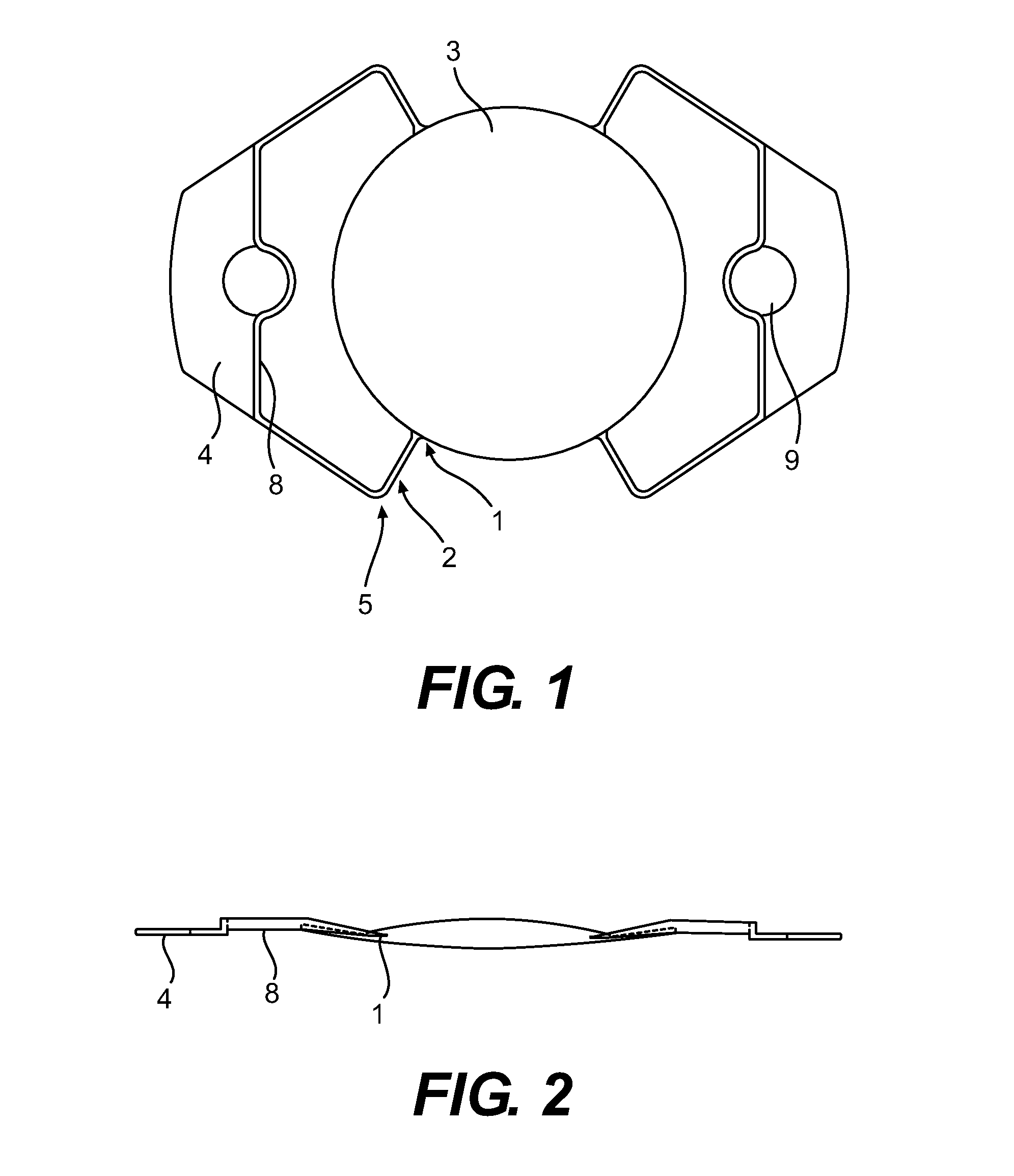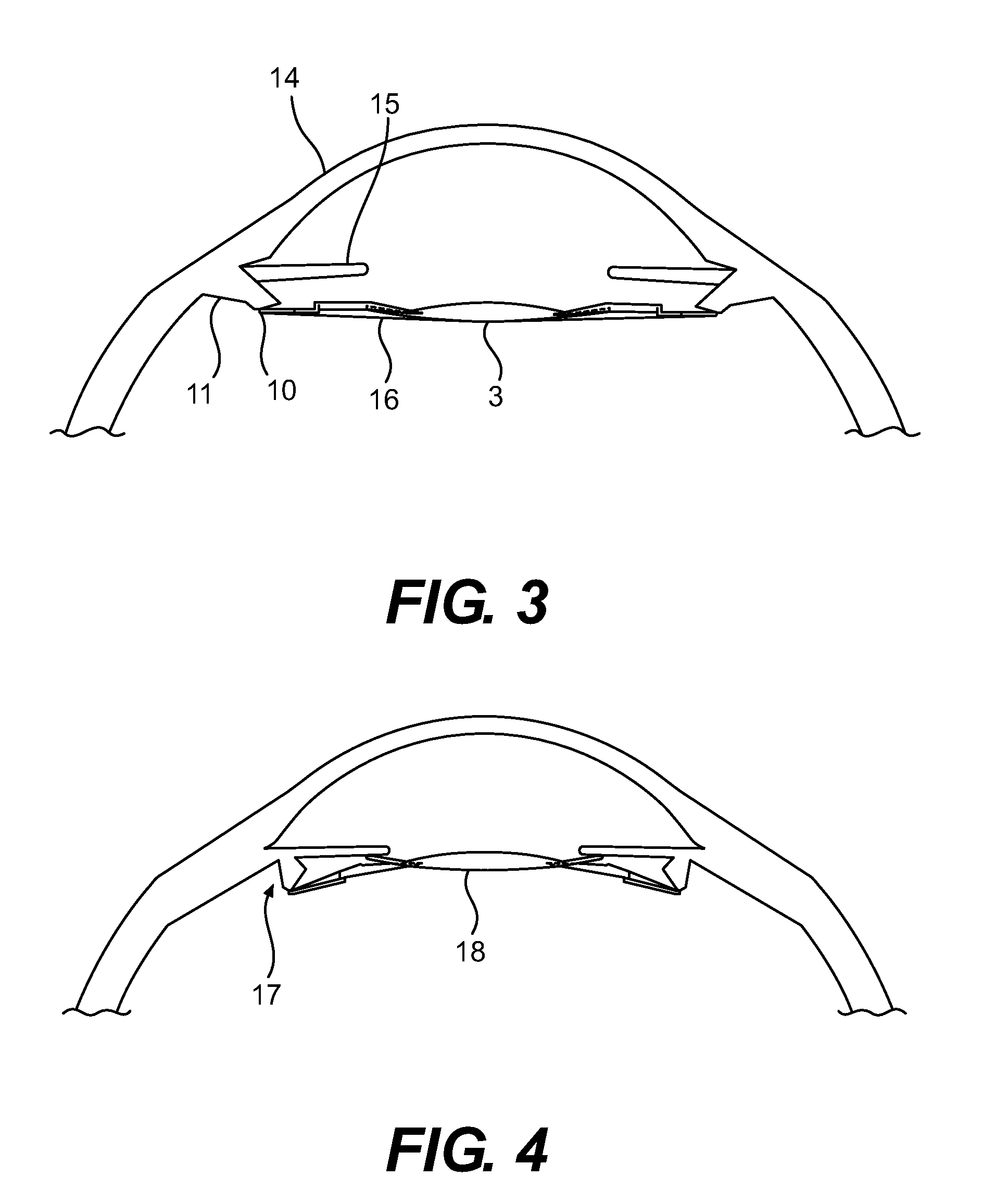Haptic devices for intraocular lens
a technology of haptic devices and intraocular lenses, which is applied in the field of haptic devices for intraocular lenses, can solve the problems of minor distortion of optics, reduced or eliminated eye's ability to change focus (accommodate), and will not return cataracts, etc., to prolong the useful life of the lens, increase the damming quality, and ensure the effect of a long li
- Summary
- Abstract
- Description
- Claims
- Application Information
AI Technical Summary
Benefits of technology
Problems solved by technology
Method used
Image
Examples
example 1
Acuity C-Well
[0119]By placing a posterior haptic loop as described herein at a ninety degree angle to the axis of the extension knobs at the polar ends of the Acuity C-Well optic, the inventive loop will maintain the capsule open, allowing full circulation of the aqueous throughout the lens capsule (see FIG. 32). The optical plate of the inventive haptic may be plano, or may be given a slightly negative power so as to enhance the effective range of accommodation by providing magnification between the lenses as the C-Well optic moves forward in the eye to the accommodative state. The outer ring of the inventive haptic preferably keeps the optic area of the posterior capsule clear of any posterior capsular opacification by corralling any cortical material outside the optic range. In the event that the ophthalmologist determines to perform an Nd-YAG laser capsulotomy, the inventive haptic plate will continue to exert posterior pressure on the posterior capsule opened by the procedure, ...
example 2
Adoptics IRAL
[0120]The Adoptics Interfacial Refractive Accommodating Lens (IRAL) consists of an optical chamber filled with two different liquids that provides accommodation by altering the curvature of the meniscus between the lenses in response to vertical pressure at the periphery of the lens. In order for this mechanism to work, a portion of the lens consists of an anterior haptic extension that is designed to rest against the inner edge of the anterior capsule and provide the downward pressure when the ciliary body moves the lens in and forward in the eye. The rest of the lens haptic consists of two plates that rest against the equator of the lens capsule, extending it so as to effectively flatten the capsule. The inventive haptic described herein, when positioned at a right angle to the longest center line of the IRAL, combined with shortening the haptic plates of the IRAL so as not to stretch the capsule at the equator, would provide several significant benefits: 1) because t...
example 3
Akkolens AKL-8
[0121]If the posterior cube of the Akkolens AKL-8 is removed and replaced by the inventive haptic described herein, and the anterior haptic arms can be extended such as to pass through the lens equator to the posterior capsule, the posterior inventive haptic would connect to an optic with negative power, thus creating enhanced accommodative effect between the lenses. Additionally, if the anterior haptic has the addition of an anterior ring to rise modestly above the plane of the haptic such that it rests securely against the inner surface of the anterior capsule, and the inventive posterior haptic is also made with a posterior ring to rest securely against the posterior capsule, the effect would be to create a lens that not only provides superior accommodation but also blocks PCO in the optic zone (see FIG. 34).
PUM
 Login to View More
Login to View More Abstract
Description
Claims
Application Information
 Login to View More
Login to View More - R&D
- Intellectual Property
- Life Sciences
- Materials
- Tech Scout
- Unparalleled Data Quality
- Higher Quality Content
- 60% Fewer Hallucinations
Browse by: Latest US Patents, China's latest patents, Technical Efficacy Thesaurus, Application Domain, Technology Topic, Popular Technical Reports.
© 2025 PatSnap. All rights reserved.Legal|Privacy policy|Modern Slavery Act Transparency Statement|Sitemap|About US| Contact US: help@patsnap.com



